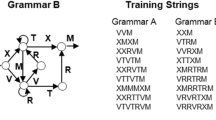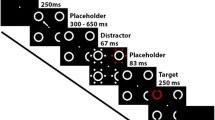Abstract
Individuals are highly sensitive to statistical regularities in their visual environment, even when these patterns do not reach conscious awareness. Here, we examine whether oculomotor behavior is systematically altered when distractor/target configurations rarely repeat, but target location on an initial trial predicts the location of a target on the subsequent trial. The purpose of the current study was to explore whether this temporal-spatial contextual cueing in a conjunction search task influences both reaction time to the target and participant’s search strategy. Participants searched for a target through a gaze-contingent window in a display consisting of a large number of distractors, providing a target-present/absent response. Participants were faster to respond to the target on the predicted trial relative to the predictor trial in an implicit contextual cueing task but were no more likely to fixate first to the target quadrant on the predicted trial (Experiment 1). Furthermore, implicit learning was interrupted when instructing participants to vary their searching strategy across trials to eliminate visual scan similarity (Experiment 2). In Experiment 3, when participants were explicitly informed that a pattern was present at the start of the experiment, explicit learning was observed in both reaction time and eye movements. The present experiments provide evidence that implicit learning of sequential regularities regarding target locations is not based on learning more efficient scan paths, but is due to some other mechanism.

Similar content being viewed by others
Notes
Each of the additional analyses reported here were conducted for Experiment 2 and Experiment 3. We only included these analyses in Experiment 1, as this experiment was the only experiment demonstrating implicit learning, though the results across all three experiments ruled out the proposed alternative explanations of the results.
References
Antes, J. R. (1974). The time course of picture viewing. Journal of Experimental Psychology, 103, 62–70.
Becker, S. I., & Horstmann, G. (2009). A feature-weighting account of priming in conjunction search. Attention, Perception, and Psychophysics, 71, 258–272.
Biederman, I. (1972). Perceiving real-world scenes. Science, 177, 77–80.
Carrasco, M., McLean, T. L., Katz, S. M., & Frieder, K. S. (1998). Feature asymmetries in visual search: effects of display duration, target eccentricity, orientation and spatial frequency. Vision Research, 38(3), 347–374.
Castelhano, M. S., & Henderson, J. M. (2007). Initial scene representations facilitate eye movement guidance in visual search. Journal of Experimental Psychology: Human Perception and Performance, 33, 753–763.
Chun, M. M., & Jiang, Y. (1998). Contextual cueing: implicit learning and memory of visual context guides spatial attention. Cognitive Psychology, 36(1), 28–71.
D’Zmura, M. (1991). Color in visual search. Vision Research, 31, 951–966.
Dick, M., Ullman, S., & Sagi, D. (1987). Parallel and serial processes in motion detection. Science, 237, 400–402.
Dodd, M. D., Van der Stigchel, S., & Hollingworth, A. (2009). Novelty is not always the best policy: inhibition of return and facilitation of return as a function of visual task. Psychological Science, 20, 333–339.
Druker, M., & Anderson, B. (2010). Spatial probability aids visual stimulus discrimination. Frontiers in Human Neuroscience, 4(63), 1–10.
Fiser, J., & Aslin, R. N. (2002). Statistical learning of higher-order temporal structure from visual shape sequences. Journal of Experimental Psychology: Learning, Memory, and Cognition, 28(3), 458–467.
Foster, D. H., & Ward, P. A. (1991). Asymmetries in oriented-line detection indicate two orthogonal filters in early vision. Proceedings of the Royal Society of London B, 243, 75–81.
Frensch, P. A., Buchner, A., & Lin, J. (1994). Implicit learning of unique and ambiguous serial transitions in the presence and absence of a distractor task. Journal of Experimental Psychology: Learning, Memory, and Cognition, 20, 567–584.
Frensch, P. A., Lin, J., & Buchner, A. (1998). Learning vs. behavioral expression of the learned: The effects of a secondary tone-counting task on implicit learning in the Serial Reaction Task. Psychological Research, 61, 83–98.
Frensch, P. A., & Miner, C. S. (1994). Individual differences in short-term memory capacity on an indirect measure of serial learning. Memory and Cognition, 22, 95–110.
Geng, J. J., & Behrmann, M. (2005). Spatial probability as an attentional cue in visual search. Perception and Psychophysics, 67(7), 1252–1268.
Jiang, Y. V., Swallow, K. M., & Rosenbaum, G. M. (2013a). Guidance of spatial attention by incidental learning and endogenous cuing. Journal of Experimental Psychology: Human Perception and Performance, 39, 285–297.
Jiang, Y. V., Swallow, K. M., Rosenbaum, G. M., & Herzig, C. (2013b). Rapid acquisition but slow extinction of an attentional bias in space. Journal of Experimental Psychology: Human Perception and Performance, 39, 87–99.
Kabata, T., & Matsumoto, E. (2012). Cueing effects of target location probability and repetition. Vision Research, 73, 23–29.
Kristjansson, A., Wang, D., & Nakayama, K. (2002). The role of priming in conjunctive visual search. Cognition, 85, 37–52.
Kunar, M. A., Flusberg, S. J., Horowitz, T. S., & Wolfe, J. M. (2007). Does contextual cuing guide the deployment of attention. Journal of Experimental Psychology: Human Perception and Performance, 33(4), 816–828.
Malcolm, G. L., & Henderson, J. M. (2010). Combining top-down processes to guide eye movements during real-world scene search. Journal of Vision, 10(2), 1–11.
McLeod, P., Driver, J., & Crisp, J. (1988). Visual search for conjunctions of movement and form is parallel. Nature, 332, 154–155.
Moraglia, G. (1989). Visual search: spatial frequency and orientation. Perceptual and Motor Skills, 69, 675–689.
Myers, C. W., & Gray, W. D. (2010). Visual scan adaptation during repeated visual search. Journal of Vision, 10(8), 1–14.
Peterson, M. S., & Kramer, A. F. (2001). Attentional guidance of the eyes by contextual information and abrupt onsets. Perception and Psychophysics, 63(7), 1239–1249.
Rosenholtz, R. (2001). Search asymmetries? What search asymmetries? Perception and Psychophysics, 63, 476–489.
Saffran, J. R. (2002). Constraints on statistical language learning. Journal of Memory and Language, 47, 172–196.
Smith, T. J., & Henderson, J. M. (2009). Facilitation of return during scene viewing. Visual Cognition, 17, 1083–1108.
Stadler, M. A. (1989). On learning complex procedural knowledge. Journal of Experimental Psychology: Learning, Memory, and Cognition, 15, 1061–1069.
Theeuwes, J. (1992). Perceptual selectivity for color and form. Perception and Psychophysics, 51(6), 599–606.
Theeuwes, J. (1994). Stimulus-driven capture and attentional set: selective search for color and visual abrupt onsets. Journal of Experimental Psychology: Human Perception and Performance, 20(4), 799–806.
Tseng, Y. C., & Li, C. S. (2004). Oculomotor correlates of context-guided learning in visual search. Perception and Psychophysics, 66(8), 1363–1378.
Wolfe, J. M., & Horowitz, T. S. (2004). What attributes guide the deployment of visual attention and how do they do it? Nature Reviews Neuroscience, 5, 1–7.
Zhao, G., Liu, Q., Zhou, P. L., Jiao, J., Li, H., & Sun, H. J. (2012). Dual-state modulation of the contextual cueing effect: evidence from eye movements during task-relevant observation. Journal of Vision, 12(6), 1–13.
Ziessler, M. (1994). The impact of motor responses on serial pattern learning. Psychological Research, 57, 30–41.
Author information
Authors and Affiliations
Corresponding author
Rights and permissions
About this article
Cite this article
McDonnell, G.P., Mills, M., McCuller, L. et al. How does implicit learning of search regularities alter the manner in which you search?. Psychological Research 79, 183–193 (2015). https://doi.org/10.1007/s00426-014-0546-8
Received:
Accepted:
Published:
Issue Date:
DOI: https://doi.org/10.1007/s00426-014-0546-8




